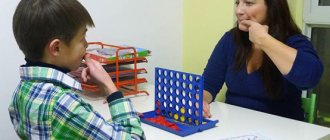Working time distribution
The first three weeks are set aside for the complete formation of groups and subgroups of children who will study with a speech therapist in the current school year.
A speech therapist works 5 days a week (the total number of hours of work per week is 20). The speech therapist teacher works directly with children for all 4 hours of his working time. The work schedule can be drawn up depending on the employment of children both in the first and second half of the day. A speech therapist teacher has the right to take students (pupils) for correctional work from any classes conducted by teachers in a group.
The workload of a speech therapist teacher at 1.0 rate provides for simultaneous speech correction work for 12 to 16 children, 20 to 25 children during the year. Children with simple and complex dyslalia are accepted; in difficult cases, the speech therapist is obliged to recommend that parents attend a special speech group. In case of refusal to transfer a child with complex speech pathology, the speech therapist teacher is not responsible for eliminating the defect.
Children are enrolled in groups on the basis of the following documents:
§ characteristics and directions of the speech therapist at the clinic;
§ opinions of doctors: otolaryngologist, psychoneurologist and dentist. Children diagnosed with FND are employed for up to 6 months, children diagnosed with FND - for 1 year.
As speech deficiencies are corrected, the speech therapist removes children from the list and replaces them with others.
Children with speech disorders of senior preschool age are selected for speech therapy classes.
The child must receive individual correctional assistance at least 3 times a week. The duration of individual lessons depends on the speech diagnosis, the age of the child, the individual developmental characteristics of the child, and his psychophysical status. The time allotted for an individual lesson with a child increases if the speech therapist himself takes the child from the group and takes him to the group after the end of the lesson.
The speech therapist teacher plans subgroup lessons if there are children of the same age with similar speech diagnoses (at least 6 children). The duration of a subgroup lesson should not exceed the time provided for by the physiological characteristics of the age (the program of training and education in kindergarten, the instructional and methodological letter “On the hygienic requirements for the maximum load on preschool children in organized forms of education”).
ORGANIZATION OF THE WORKING TIME OF A Speech Pathologist
ORGANIZATION OF Speech Therapy PROCESS
Since speech therapy centers operate, as a rule, at secondary schools, the beginning and end of the school year, the time and duration of vacations correspond to the standards established in schools. The duration of the next vacation for speech therapists also corresponds to the duration of the next vacation for teachers of secondary schools.
The teaching load of speech therapists is 20 academic hours per week. (Order of the Ministry of Education of the USSR No. 94 of May 16, 1985 and Instructions on the procedure for calculating wages of educators, paragraph 87, subparagraph B.)
After leaving the next vacation until September 1, the speech therapist checks the condition of the equipment in the speech therapy room: technical teaching aids, lighting, etc.; inspects visual and educational aids and brings them into working condition; prepares the necessary documentation and visual and speech material for examining students. If necessary, the speech therapist teacher replenishes his arsenal of visual educational aids by producing them himself. On these same days, the speech therapist gets acquainted with the personal files of students newly enrolled in school.
DISTRIBUTION OF TIME ALLOCATED FOR INVESTIGATION OF STUDENTS' ORAL AND WRITTEN SPEECH
The first two weeks of the school year (from September 1 to September 15) are set aside for the complete formation of groups and subgroups that will study at the speech therapy center in the current school year. To do this, the teacher-speech therapist conducts an examination of the oral speech of students admitted to the first grades of the school, at the same time the teacher-speech therapist clarifies the lists of groups pre-compiled by him in May of the previous school year from among students in grades 2-4.
The examination of first-graders’ oral speech is carried out in two stages. During the first week of September, the speech therapist teacher conducts a preliminary examination of the oral speech of all students admitted to the first grades and identifies children who have certain deviations in speech development. At the same time, he selects those students who need systematic correctional classes. This is done in the morning during school hours.
During the second week of September, the speech therapist teacher conducts a secondary in-depth examination of the oral speech of those children whom he selected for classes at the speech center during the preliminary examination. A secondary in-depth examination of children’s oral speech is carried out in a speech therapy room or in any convenient room of the school attached to the speech center during the second half of the day, i.e. after school.
Regular classes at the speech therapy center are held from September 16 to May 15.
The last two weeks of May (from May 16 to May 31) are reserved for examining the oral and written speech of students in grades 1–3 with the aim of pre-compiling groups with writing and reading disabilities for the new school year. (Students in 4th grade are not surveyed due to the fact that they are moving on to secondary school.)
All organizational work of the speech therapist teacher, carried out from September 1 to 15 and from May 16 to 31, is recorded on the corresponding page of the “Attendance Record Book”.
DISTRIBUTION OF TIME ALLOCATED FOR EDUCATIONAL AND CORRECTIONAL WORK.
By September 15, the speech therapist teacher completes the examination of students’ oral and written speech, finally completes groups and subgroups, determines the number of students for individual lessons and, based on this, draws up a lesson schedule and long-term plans for working with each group of students.
The class schedule is compiled based on the following time parameters:
lesson time for a group of 1st grade students is 35 minutes, for a group of 2nd to 4th grade students is 45 minutes;
class time with a subgroup - 20-25 minutes;
The time for individual lessons is 15-20 minutes with each student.
Between group classes, breaks of 10-15 minutes are allowed, between subgroup classes - 5-10 minutes. The teacher-speech therapist can use this period of time to check written work completed by students during the lesson, record and analyze the mistakes made, so that when planning the next lesson, provide for work to correct these errors, as well as for other work at his discretion: the speech therapist can conduct a group of children and separate them into classes or, conversely, gather a group of children (this is sometimes necessary in the first months of working with first-graders, especially 6-year-olds), prepare a board or lay out visuals and handouts for the next lesson, etc.
The speech therapist determines the number of working hours per day depending on the operating mode of the schools attached to the speech center (one shift or two shifts), the number of groups and subgroups, the presence of a branch, etc.
A prerequisite is speech therapy classes after school. Students who do not attend extended day groups come to classes from home. Pupils who attend extended-day groups are sent by teachers of extended-day groups to speech therapy classes from any scheduled moment in accordance with the schedule of speech therapy classes. This schedule should be known to teachers and be in each extended day group. Teachers of extended day groups do not have the right to detain a child or not allow him to attend classes with a speech therapist due to his slow completion of homework or any other reason. Just like a primary school teacher cannot independently decide whether his student should attend speech therapy classes or not. If a speech therapist has conflicts of this kind, he reports the unauthorized actions of the educator or teacher to the school director, and if proper measures are not taken, to the inspector of the district department of public education.
The schedule of speech therapy classes is drawn up in such a way that each group of students studies 3 times a week, preferably at the same time. This is especially true for groups of 1st grade students. Classes with groups of 3rd grade students who have a writing disorder due to immaturity of phonemic processes, as well as classes with mixed groups of 2nd-3rd and 3rd-4th grade students who have a writing impairment due to immaturity of phonemic processes can be carried out 2 once a week. Work on correcting sound pronunciation in subgroups and individually is carried out at the discretion of the speech therapist 1-3 times a week in each subgroup or with each student, depending on the severity of the speech defect.
Note: taking into account the special regime of the school day for 1st grade students and their age-related psychological characteristics, it is advisable to conduct classes with groups of these students after a nap, i.e. after 16 hours.
DISTRIBUTION OF WORKING TIME OF A Speech Pathologist TEACHER DURING SCHOOL HOLIDAYS
School holidays are always filled with various kinds of events that are organized and conducted by teachers. Some students go during the holidays to camps, holiday homes, on excursions, etc., so speech therapy classes are not conducted during the holidays.
During the autumn holidays, the teacher-speech therapist fills out the necessary documentation, conducts an additional examination of the state of written speech of students in grades 2-4 based on written work, in order to identify dysgraphic children and monitor students who previously studied at a speech therapy center. If there are free places in the group with a writing disorder, it is replenished with new students.
During the winter holidays, a speech therapist teacher examines the state of written speech of 1st grade students using copybooks and notebooks. In addition, he replenishes the equipment of the speech therapy room with the necessary visual aids, educational tables, posters, etc., visits the district (city) methodological office and fellow speech therapists to exchange work experience, conducts conversations and consultations for parents of students involved in speech therapy center.
In the event that there are no specialized speech therapy preschool institutions in the area of the speech therapy center (or speech therapy groups at mass kindergartens) and there is no speech therapist in the district children's clinic, the teacher-speech therapist turns out to be the only speech therapist in the area, so during the spring holidays at school he conducts examinations of children in kindergartens closest to the speech therapy center. He checks the state of oral speech of children who will come to school in the fall. The speech therapist identifies children with speech disorders and makes an appropriate entry in the exchange medical records.
If there are other speech therapists in the school area (in preschool institutions or a children's clinic), then during the spring holidays it is advisable to carry out a method of association between speech therapists at school speech therapy centers and speech therapists at preschool institutions to develop measures to ensure continuity in the work of school and preschool speech therapists.
In addition to the work listed above, during school holidays, the teacher-speech therapist, as necessary, consults students studying at the speech therapy center with specialist doctors (psychoneurologist, neurologist, otolaryngologist), and invites more experienced speech therapist colleagues to consult on individual difficult children. It is necessary to take into account that a child’s consultation with any medical specialist is possible only with the consent and in the presence of one of the parents or a person replacing them. If the parents or the person replacing them give their consent to the consultation, but cannot be present during it, the speech therapist must have a written statement that the parents allow the speech therapist to show the child to a specialist doctor (with a mandatory indication of which specialist). ).
A speech therapist teacher can use vacation time to conduct speech therapy propaganda among parents and the population of the area.
WORK OF A Speech Pathologist TEACHER IN JUNE.
June is the most convenient time to improve the professional level of speech therapists. Therefore, it is advisable for district (city) methodological offices and teacher training institutes to organize month-long courses and seminars in June to exchange best practices. Similar seminars can be organized by senior speech therapists in their areas. Speech-language pathologist teachers can attend such seminars organized in other districts.
If there are no speech therapy preschool institutions in the school area (or speech therapy groups in mass kindergartens) and a speech therapist in the district children's clinic, a teacher-speech therapist can organize classes in June with children who have impaired sound pronunciation, who will go to schools attached to this speech therapy center for the purpose of correcting sound pronunciation. These classes are held either in the kindergarten at a time agreed with the head or group teachers, or in the speech therapy center.
A teacher-speech therapist can conduct similar classes on correcting sound pronunciation with children already enrolled in the first grades of schools attached to a speech therapy center, for whom sound pronunciation disorders were noted upon enrollment.
In addition, admission of students to first grade begins in April. The speech therapist of the school speech therapy center must necessarily take part in the recruitment of the first classes, identifying children with speech development disorders upon admission and, if necessary, referring them to a consultation with a specialist (neurologist, psychoneurologist, otolaryngologist).



